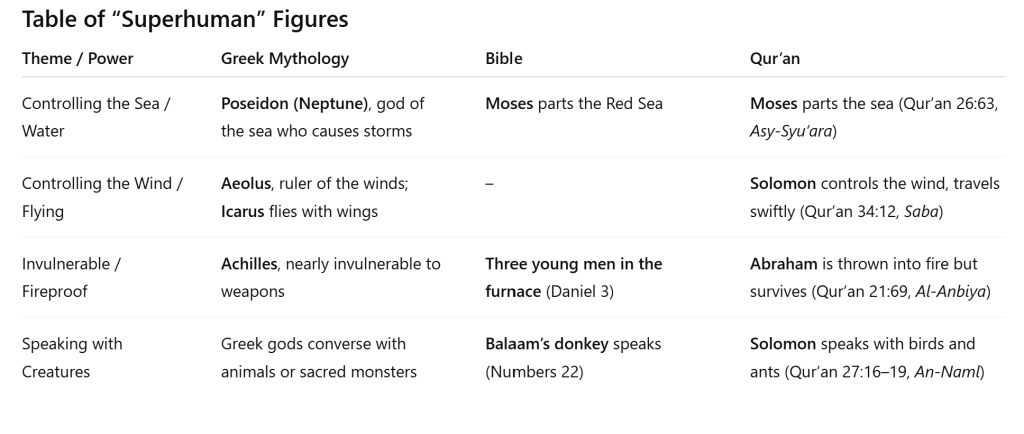
Ancient Greek mythology was already widely known from around 2000 BC until the early Common Era. Stories of Hercules with immense strength, Achilles who was nearly invulnerable, Poseidon who ruled the seas, or Icarus who could fly, were passed down through oral tradition and classical literature. Meanwhile, the Bible’s miracle stories were written centuries later, and the Qur’an appeared in the 7th century CE (610–632 CE).
This long gap raises the question: could the miracle stories of the Bible and the Qur’an be a continuation of, or influenced by, the narrative patterns of much older mythology?
The Bible’s Composition Timeline
The Bible was not written in one sitting, but compiled over more than a thousand years by many authors.
- Old Testament (Hebrew Tanakh): Written between about 1200 BC – 165 BC. The oldest parts (Pentateuch, stories of Moses) may date back to the 12th–10th century BC. The youngest (Daniel, Maccabees) were completed in the 2nd century BC.
- New Testament: Written between about 50 CE – 100 CE. Paul’s letters are the earliest (≈50–60 CE). The Gospels were written between 65–100 CE. Revelation was probably the last (≈95 CE).
Greek Mythology’s “Super-human” Themes
Greek myths featured extraordinary beings and “super-human” feats:
- Poseidon controls the sea and storms.
- Zeus hurls thunderbolts.
- Icarus flies with crafted wings.
- Hercules has superhuman strength.
- Some figures are born through divine intervention, without a human father.
As with scripture, these myths present humans or demi-humans who transcend normal limits.
Miracles in the Bible
The Bible contains many miracles:
- Moses parts the sea, turns his staff into a serpent.
- Jesus raises Lazarus from the dead, heals the sick, expels demons.
- Jesus is born without a biological father.
- Elizabeth gives birth at an advanced age.
- God sends floods, earthquakes, and other calamities.
These stories present humans who seem to break the laws of nature, resembling “super-humans.”
Miracles in the Qur’an
The Qur’an continues similar traditions:
- Moses parts the sea and his staff becomes a serpent.
- Jonah survives inside a great fish.
- Abraham survives being thrown into fire.
- Khidr knows the unseen.
- Solomon commands the wind, speaks with birds and ants, and leads the jinn.
- God sends natural disasters as divine signs.
The patterns strongly resemble the Bible’s miracle stories.
The 7th Century: A World of Myth
When the Qur’an was revealed, the world was still steeped in myth:
- Jewish-Christian stories were well-established in the Middle East.
- Greek-Roman mythology still influenced Europe.
- Arabian traditions included jinn and supernatural legends.
Thus, spectacular miracle narratives were part of the cultural “normal.”
Read more: